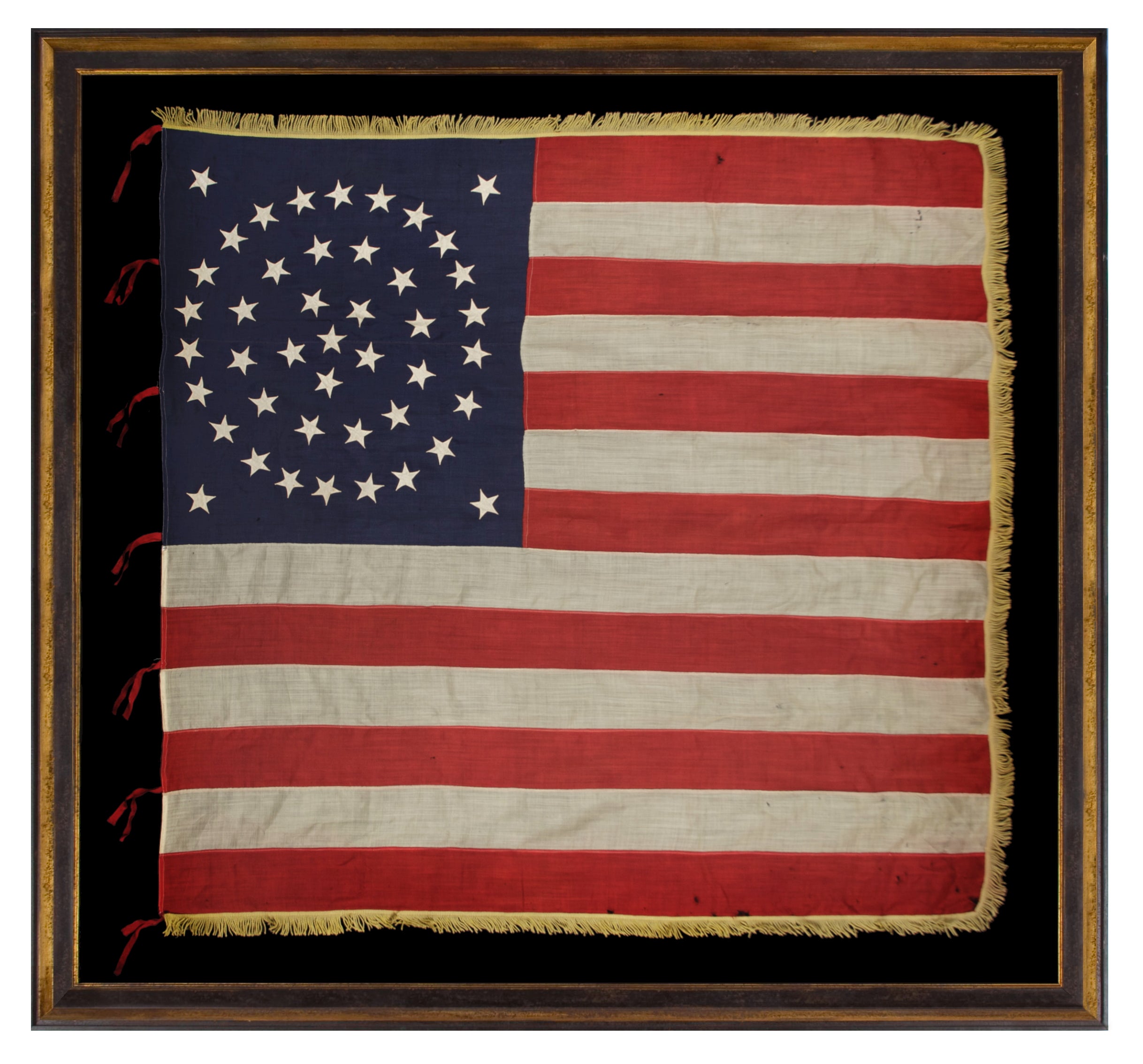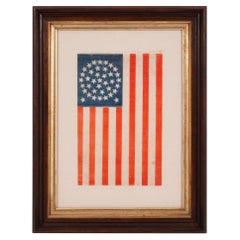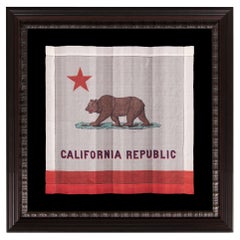About Jeff R. Bridgman American Antiques
As an advisor to top museums and collectors alike, Jeff Bridgman is the world's leading expert and source for antique American flags and political textiles. In this field there are many fakes, forgeries, and misrepresented items, and there is no substitute for experience. As the nation's leading buyer and seller, Jeff R. Bridgman Antiques, Inc. has handled more material than anyone in the field. Jeff has also operated a textile conservation business for 18 years, where expert staff have conservation mounted, framed and restored thousands of examples, more than anyone ...Read More
Featured Pieces
38 Star Antique American Parade Flag, Colorado Statehood, ca 1876-1889
Located in York County, PA
38 STARS IN AN EXTREMELY UNUSUAL CONFIGURATION THAT BEARS A CLUSTER OF 6 SMALL STARS WITHIN A LINEAL PATTERN OF LARGER STARS, 1876-1889, COLORADO STATEHOOD
38 star American national parade flag, printed on cotton. This is an extremely rare example of a lineal pattern flag with a wreath or cluster of smaller stars inserted in the center. A very small number of flags in this style are known to have survived, the colors of which are typically saturated and vibrant, like this example, in scarlet red and rich, royal blue.
The particular wreath in the center of the configuration is really more of a pentagon with a single, center star. The reason for the choice of the design and 6 smaller stars seems a curious one on the surface, but its purpose was probably nothing more than to simply augment a 36 star print block to one with 38 stars. One may observe how 4 stars, that would have comprised the center of a 6 x 6 pattern, could have simply been removed and 6 smaller stars inserted in their place, in an artful fashion.
At least two other similar 38-star patterns are known that incorporate 4 small stars intermingled between rows of what most certainly were two very similar 34-star flag print blocks originally. It was easier to modify these blocks rather than create brand new ones. In these particular instances, the results are rare, quirky configurations that are highly prized by collectors.
Colorado became the 38th state on August 1st, 1876. This was the year of our nation’s 100-year anniversary of independence. Per the Third Flag Act of 1818, stars were not officially added until the 4th of July following a state's addition. For this reason, 37 was the official star count for the American flag in 1876. Flag-making was a competitive venture, however, and few flag-makers would have been continuing to produce 37 star flags when their competitors were making 38’s. It is for this reason that 38 and 13 stars (to represent the original 13 colonies) are more often seen at the Centennial International Exposition, the six-month long World’s Fair held in Philadelphia in honor of the event. Some flag-makers would have been adding a star for the 38th state even before it entered the Union, in the early part of 1876 or even prior. In fact, many makers of parade flags were actually producing 39 star flags, in hopeful anticipation of the addition of two more Western Territories instead of one. But the 39th state would not join the Union for another 13 years, when the Dakota Territory entered as two states on the same day. The 38 star flag became official on July 4th, 1877 and was generally used until the addition of the Dakotas in 1889.
Provenance: Jeff R. Bridgman Antiques to the late collector Jim Ring...
Category
Antique Late 19th Century American Political and Patriotic Memorabilia
Materials
Cotton
38 Star Parade Flag with Stars in a Medallion Configuration, ca 1876-1889
Located in York County, PA
38 STARS IN A MEDALLION CONFIGURATION WITH 2 OUTLIERS, ON AN ANTIQUE AMERICAN FLAG WITH VIBRANT COLORATION, REFLECTS COLORADO STATEHOOD, 1876-1889, ILLUSTRATED IN “THE STARS & STRIPES: FABRIC OF THE AMERICAN SPIRIT” by RICHARD PIERCE, 2005
38 star American parade flag, printed on coarse, glazed cotton. The stars are arranged in a triple-wreath form of the medallion configuration, with a single center star and two stars flanking outside the basic pattern, toward the fly end. Most circular medallion patterns of this sort exhibit four flanking stars beyond the consecutive wreaths, one in each corner. The inclusion of only two was intentional, allowing for the easy addition of two more stars. Flag-makers knew that more Western Territories were soon to be added and eagerly anticipated their arrival. Use of fewer than four outliers was popular in 38 star parade flags, but is rarely encountered in other star counts.
Note how the vibrant, chromatic luster of the orange stripes provides striking contrast with the blue canton, and how this contributes to the flag's beautiful presentation. Many parade flags in this star count have red stripes that lean heavily toward orange. This was common across printed flags produced between the 1850's and the 38 star period, phasing out in the last decade of the 19th century.
Colorado became the 38th state on August 1st, 1876. This was the year of our nation’s 100-year anniversary of independence. Per the Third Flag Act of 1818, stars were not officially added until the 4th of July following a state's addition. For this reason, 37 was the official star count for the American flag in 1876. Flag-making was a competitive venture, however, and few flag-makers would have been continuing to produce 37 star flags when their competitors were making 38’s. It is for this reason that 38 and 13 stars (to represent the original 13 colonies) are more often seen at the Centennial International Exposition, the six-month long World’s Fair held in Philadelphia in honor of the event.
Some flag-makers would have been adding a star for the 38th state even before it entered the Union, in the early part of 1876 or even prior. In fact, many makers of parade flags were actually producing 39 star flags, in hopeful anticipation of the addition of two more Western Territories instead of one. But the 39th state would not join the Union for another 13 years, when the Dakota Territory entered as two states on the same day. The 38 star flag generally fell from use at that time, though it technically remained official until July 3rd, 1890.
President Ulysses S. Grant was in office when the first 38 star flags would have appeared. The list of presidents serving during the period when the 38 star flag was actually official, include Rutherford B. Hayes, James Garfield...
Category
Antique Late 19th Century American Political and Patriotic Memorabilia
Materials
Cotton
Early California Republic Kerchief, Likely Made at the Panama-Pacific Expo 1915
Located in York County, PA
EARLY KERCHIEF IN THE FORM OF THE CALIFORNIA STATE BEAR FLAG, PROBABLY MADE FOR THE PANAMA-PACIFIC INTERNATIONAL EXPOSITION IN SAN FRANCISCO IN 1915
Printed on silk, this beautiful ...
Category
Early 20th Century American Political and Patriotic Memorabilia
Materials
Silk
Rare Suffragette Armband in Golden Yellow Felt, ca 1912-1919
Located in York County, PA
RARE SUFFRAGETTE ARMBAND IN GOLDEN YELLOW FELT, ONE OF ONLY TWO EXAMPLES THAT I HAVE ENCOUNTERED IN THIS COLOR & THE ONLY ONE IN THIS EXACT STYLE; MADE circa 1912-1919:
Wide, felt ...
Category
Vintage 1910s American Political and Patriotic Memorabilia
Materials
Felt
Oversized, Paint-Decorated Baseball Bat Presented to J. Whipple
Located in York County, PA
Over-sized, Paint-Decorated Baseball Bat, Presented To "J. Whipple" of the "Erie Baseball Club," circa 1858-1870s
This remarkable bat, the best 19th century example that I have ever seen, was was presented to "J. Whipple" of the "Erie Baseball Club."
Painted red, white, blue, and black, the bat it is decorated in gold with the club's crest. The inscribed date of 1871 may have been added later. This could certainly be accurate in terms of its year of use, though it may actually pre-date this. In combination with the date of the Erie Baseball Club of Buffalo, the painted surface and crest suggest a date between 1858 and perhaps the 1870's at the latest. The graphics of the crest are more indicative of the mid-19th century than the latter decades.
The "J. Whipple" on the bat may have been Joseph Oliver Whipple of Buffalo, New York (b. abt. 1830 in NY, d. 14 Oct 1884 in Buffalo, NY -- died in the Erie Canal). There was a baseball club by that name in Buffalo, founded in 1858. There were at least two other clubs by the same name, however, in the same period. One was located in Troy New York...
Category
Antique Mid-19th Century American Sculptures and Carvings
Materials
Wood
Centre County Pennsylvania Blanket Chest with Salmon and Black Floral Decoration
Located in York County, PA
PAINTED, CENTRE COUNTY, PENNSYLVANIA BLANKET CHEST IN SALMON AND BLACK WITH FLORAL DECORATION, 3 DRAWERS, AND APPLIED, SPLAY FEET, circa 1815-1825
S...
Category
Antique Mid-19th Century American Painted Furniture
Materials
Wood
34 Star Antique American Flag with Hourglass Medallion Stars, ca 1861-1863
Located in York County, PA
EXTRAORDINARY 34 STAR ANTIQUE AMERICAN FLAG WITH AN ACCORDION OR HOURGLASS MEDALLION CONFIGURATION THAT SURROUNDS A PENTAGON OF STARS IN THE CENTER; MADE OF FINE SILK AND ENTIRELY HAND-SEWN; MADE DURING THE OPENING YEARS OF THE CIVIL WAR (1861-63), IN A TINY SIZE AMONG ITS COUNTERPARTS OF THE PERIOD; REFLECTS THE ADDITION OF KANSAS AS THE 34TH STATE
34 star flag of the Civil War period with an array of rare, beautiful, and otherwise desirable features. Extremely small among flags of this period with pieced and sewn construction, the flag displays a star pattern that is not only highly unusual, but unique to this particular example. This consists of a single star in the very center, surrounded by a pentagon of stars, flanked by angular bracket of three stars to either side. Above and below are rows of 5 stars, followed by rows of 6 that line the top and bottom of the canton. The resulting configuration is what I have termed an “accordion medallion,” though “hourglass medallion” or “standing bow tie” would be perfectly acceptable.
When rotated 90 degrees, to view the harder-to-identify, bow tie formation, students of early star patterns may note the visual similarity between this and what I call “Starburst” or “Crosshatch” medallions. The pattern, however, conspicuously lacks the crosses of St. Andrew (a saltire) and St. George (roman cross), that would allow it to be more accurately categorized as such.
Entirely hand-sewn, the canton and stripes of the flag are made of fine silk. The hemming of this was accomplished with great skill. The top and bottom edges are selvedge. These are so similar in nature as to have come from the same maker. There is a white, silk binding along the hoist, in the form of an open sleeve, through which a length of braided hemp rope was passed, expertly looped and re-braided into itself at the top and bottom for strength.
The stars are made of white, polished cotton. These were stitched to both sides (double-appliqued). Note how the edges of the fabric were not turned under, providing evidence of the fact that the maker was not especially skilled in appliqueing. This was common, as applique work was far more difficult than producing French seams.
In the 19th century, most flags with pieced and sewn construction were 8 feet long and larger. A six-footer was considered small. Even military battle flags, carried on foot, measured 6’ x 6.5’, which translates into approximately 7’ x 7.5’ after framing, about the size of an average quilt and larger than can comfortably fit on a wall in a house with 8-foot ceilings and average width baseboard. Flags smaller than this were produced both commercially and at home, but the smaller they are, the more unusual they are. At just 26.5 x 46.5 inches, this flag is extremely small for a Civil war period flag with sewn construction.
Silk was both beautiful and lightweight, which made it elegant for military unit colors and preferable for flags meant to be carried on foot. Most outdoor use flags...
Category
Antique 1860s American Political and Patriotic Memorabilia
Materials
Silk
West Point Pennant with Striking Colors and Graphics, ca 1940-1950
Located in York County, PA
WEST POINT PENNANT WITH STRIKING COLOR & GRAPHICS, WWII ERA - 1950's
Triangular pennant, made for the United States Military Academy at West Point, with exceptional colors and graph...
Category
Mid-20th Century American Political and Patriotic Memorabilia
Materials
Felt
42 Star Antique American Parade Flag, Ca 1889-1890
Located in York County, PA
42 STARS ON AN ANTIQUE AMERICAN FLAG WITH SCATTERED STAR POSITIONING, REFLECTS THE ADDITION OF WASHINGTON STATE, MONTANA, AND THE DAKOTAS, NEVER AN OFFICIAL STAR COUNT, circa 1889-18...
Category
Antique Late 19th Century American Political and Patriotic Memorabilia
Materials
Cotton
13 Star Antique American Flag, ca 1895-1926
Located in York County, PA
13 STAR ANTIQUE AMERICAN FLAG WITH A 3-2-3-2-3 CONFIGURATION OF STARS ON AN INDIGO CANTON, SQUARISH PROPORTIONS, AND A BEAUTIFUL OVERALL PRESENTATION, MADE circa 1895-1926
This 13 s...
Category
Antique Late 19th Century American Political and Patriotic Memorabilia
Materials
Wool
33 Star Flag with Stars in a "Great Star" Pattern, Oregon State, ca 1859-1861
Located in York County, PA
33 STARS IN A "GREAT STAR" PATTER ON A BRILLIANT, ROYAL BLUE CANTON, A RARE AND EXTRAORDINARY EXAMPLE, PRE-CIVIL WAR THROUGH THE WAR'S OPENING YEAR, 1859-1861, OREGON STATEHOOD
33 s...
Category
Antique Mid-19th Century American Political and Patriotic Memorabilia
Materials
Silk
44 Star Antique Parade Flag, Hourglass Formation, Wyoming Statehood ca 1890-1896
Located in York County, PA
44 STAR ANTIQUE AMERICAN FLAG WITH AN HOURGLASS FORMATION ON A BRILLIANT BLUE CANTON; REFLECTS THE ERA WHEN WYOMING WAS THE MOST RECENT STATE TO JOIN THE UNION, 1890-1896
44 star Am...
Category
Antique Late 19th Century American Political and Patriotic Memorabilia
Materials
Cotton
More About Jeff R. Bridgman American Antiques









